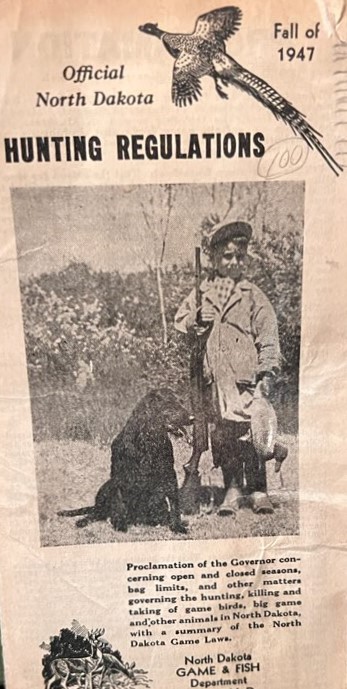
Our Outdoors: History’s Guide
By Nick Simonson
One finds the outdoors in the strangest of places. On the final weekend of the 2022 hunting calendar, my wife, sons, and I joined much of our extended family for a make-up Christmas of sorts, ringing in the new year and catching up on those holiday festivities that the recent winter weather made impossible. With the feasting and singing and reminding of what it really is to be a Minnesota Vikings fan complete, I snuck off and returned to what I do in the quiet hours in my mother’s house when I visit as of late: searching for the scattered singles and sleeved cards of days gone by, be they old baseball cards of my father’s, basketball cards my brother and I collected, or those from trading card games we played in our younger years.
Sifting through the paperwork haphazardly stashed in the drawers of the den, amidst crushed pencil lead and rusty paperclips, underneath a small stack of NBA Hoops cards, a couple of sleeved Shaquille O’Neals and a Hakeem Olajuwon, and some bent and battered Magic: The Gathering cards was a paper far older than all the other contents of the drawer. On its cover a boy of not more than 10 stood with a shotgun looking something like an old Browning A-5, and in classic lab fashion, his black dog was staring off and away from the camera, the luxury of 100-photo digital bursts required to get one good shot of such a dog still some 50 years down the road. In the boy’s hand was a worn wooden decoy.
Dated the “Fall of 1947” the five-fold pamphlet was titled the “Official North Dakota Hunting Regulations.” Its worn pages, now 75 years old in full with the close of this season, looked something like those found in the stack of dusty and cracked prayer books I had found as a kid in the basement of our church. Near the pheasant which arched over the title of the paper were 12 lines, next to the number 100 in a hand-drawn circle. I couldn’t tell if the marks were a tally of birds taken in that year and the number was perhaps the total seen, or perhaps they were just a doodle and a quick note pertaining to something else.
Unfolding the proclamation, authorized by then-Governor Fred G. Aandahl, I caught a glimpse into a world of hunting far different and far shorter than the one we enjoy today. Under the section devoted to Sharptailed Grouse, only that portion of the Peace Garden State west of the Missouri River was open to hunting the state’s native upland bird, and the season ran 10 days from Oct. 15 to Oct. 24. Seasons for other grouse and partridge species were closed. For pheasants, the open season was broken down based on counties, with those stretches between the badlands in the west and angling toward Wahpeton in the southeast open to hunting. Portions of Burleigh and Kidder counties, along with Dickey, Sargent and Richland had a two-bird limit and only a 10-day season. Those counties in the western portion of the open area had a three-bird bag and a 29-day season.
The Deer map within the yellowed brochure required closer inspection as dotted counties and those with angled hatching separated the options available to hunters in the five-day season running from the Friday to the Tuesday before Thanksgiving that year. Counties in the east and west were limited to bucks only with two or more prongs per antler (as opposed to the modern “points” term most hunters use for counting antler tines today) with a stretch in the central portion of the state and north of Devils Lake allowing for the harvest of a doe or a buck.
On the back of the pamphlet was a summary of other game laws for the biennium of 1947-1948 (which remains akin to the state’s every-other year lawmaking sessions that are still in place today) setting the rules for the following seasons. A fishing license cost a mere fifty cents. The season for perch, pike, and northern pike (with the first reference to “pike” likely being walleye, then often called “walleyed pike” by sportsmen) ran from May 16 to Oct. 31. The season for bass, crappies and sunfish was open from June 16 to Oct. 31 and a 10-inch minimum size limit was required for pike and largemouth and crappies and sunfish needed to be more than six and five inches respectively in order to be kept.

It was pretty simple; an entire two-year stretch was summed up in 10 little pages, one of which was the cover. Certainly, the seasons were shorter, the technology available to hunters far less, the populations of game species likely smaller and not as well-established through management processes available at the time and the percentage of the hunting public was much tinier than it is today, all accounting for far less paper required to set the rules. Where various state hunting regulation booklets span hundreds of pages now, many of which incorporate advertisements for fishing gear and hunting brands to offset the costs, the proclamation of 1947 represented far simpler times, though it did, at the bottom of Page 10, make a plug for the state-owned mill’s brand of “Dakota Maid” Flour.
Thinking it over, as my dad was born in November of that year, the guide was certainly not his. The handwriting on the cover reminded me of my grandmother’s, and she had told me incredible tales of hunting pheasants, grouse and prairie chickens as a young lady from the hood of a pickup driven through the wild west of the North Dakota prairie grasses, long before even these simple regulations were in place; but it was unlikely it was hers, either. I couldn’t place receiving it on my own sometime in the past 20 years, but the folly of memory suggested that some person who shared my interest in hunting and fishing passed it along, and I went with that as I gently folded it up and planned its preservation. Wherever its origins, and whoever possessed it before me, it was in my hands now, secured alongside Shaq and the Dream in a binder as a piece of history and days gone by…in our outdoors.
